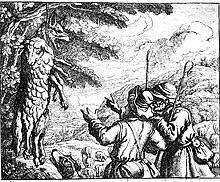Wolf in sheep's clothing
Wolf in sheep's clothing is a phrase borrowed from the Bible . It is used for someone who tries to disguise harmful intentions with a harmless appearance. The origin was wrongly ascribed to the fables of Aesop and is classified in the list of motifs ( Perry index ) 451. It was later adopted as a metaphor by the Brothers Grimm in The Wolf and the Seven Young Goats .
origin
The phrase comes from a sermon by Jesus in the New Testament : But beware of the false prophets who come to you in sheep's clothing, but inside they are ravening wolves. ( Mt 7.15 ELB ). Their true nature will be revealed through their deeds ( You shall recognize them by their fruits , verse 16). In the centuries that followed, the phrase was used extensively in the Latin writings of the Church Fathers and later in literary works in European languages. A Latin proverb says: Pelle sub agnina latitat mens saepe lupina . (A wolfish sense is often hidden under the skin of a sheep).
Although the story of the wolf in sheep's robe was ascribed to Aesop in modern times , it is nowhere mentioned in writing before the 12th century and is missing in the most important sources of fables. Additional evidence of folkloric origins is provided by the fact that the motif of the disguised wolf has different moral applications in three different stories. Later narratives follow these respective strands.
The first variant was handed down by the Greek rhetor Nikephoros Basilakis in his Progymnasmata (rhetorical exercises) in the 12th century . It is provided with the introductory remark: "You can get into trouble through a disguise".
“A wolf decided to get more food by changing its appearance. He covered himself in sheep's clothing and accompanied the herd to the pasture. The shepherd was fooled by the disguise. When night fell, the shepherd locked the wolf and the rest of the flock securely in the sheepfold with a gate. But when the shepherd brought a sheep for his supper, he took the knife and killed the wolf. "
The moral of the story is different from the biblical one, which warned of the hypocritical evildoers. Nikephorus shows that the evil deed is quickly followed by punishment.
The second version did not appear until three centuries later in the 15th century in the Hecatomythium of the Italian scholar Laurentius Abstemius .
“A wolf clad in sheepskin mingled with the herd and killed a sheep every day. When the shepherd noticed this, he tied the wolf to a high tree. When the other shepherds asked why he hanged a sheep, he replied: The skin is that of a sheep, but the deeds were that of a wolf. "
Abstemius' moral of the story follows the biblical interpretation: "People are not to be judged by their outward appearance but by the works, and some dressed in sheep's clothing do the work of wolves." The most common retelling of the story in English follows Abstemius and the Attributions by Aesop.
Another variant appears in the Cento Favole morali by the Italian poet Giovanni Maria Verdizotti (1525–1600).
“A wolf disguised itself as a shepherd, but when it tried to imitate its call, it woke the real shepherd and his dogs. Since the wolf was hindered by its camouflage, it could not escape and was killed. "
This version follows Jean de La Fontaine in his fables (III.3). The morality pursued by both poets corresponds to that of Nikephorus. The story came under the title "Der Wolf als Hirte" (The Wolf turned Shepherd) in the canon of the English 1884 edition of Aesop's Fables .
Representation in art
Earlier accounts of the fable focused on the execution of the wolf. More recently, the focus has been on disguise. In France the subject of the wolf as a shepherd is more common.
literature
- Dagmar Langwald: Fascination Wolf: Experiences, stories and legends from all over the world . The wolf in sagas, legends and myths from all over the world but also from a scientific point of view, Stocker, Graz 2002, ISBN 3-85365-188-7 .
- Edin Løvås: Wolves in Sheep's Clothing: Power people in the community (original title: Maktmennesket i menigheten, translated from Norwegian by Andreas Ebert). Brendow, Moers 2010, ISBN 978-3-87067-882-1 .
Web links
- Book illustrations from "The Wolf in Sheep's Clothing"
- Book illustrations from "The Wolf as Shepherd"
Individual evidence
- ↑ http://www.earlychristianwritings.com/e-catena/matthew7.html
- ↑ De Gruyter, Thesaurus proverbiorum medii Aevi , Berlin, 2000, p. 2 ( online in the Google book search)
- ↑ Fable 76; the version in original Latin here http://eclassics.ning.com/profiles/blogs/727885:BlogPost:5585
- ↑ # English translation online
- ↑ The Victoria & Albert Museum presents a selection ( Memento from September 18, 2010 in the Internet Archive )
- ↑ An example by Gustave Doré ( Memento from December 25, 2010 in the Internet Archive )
